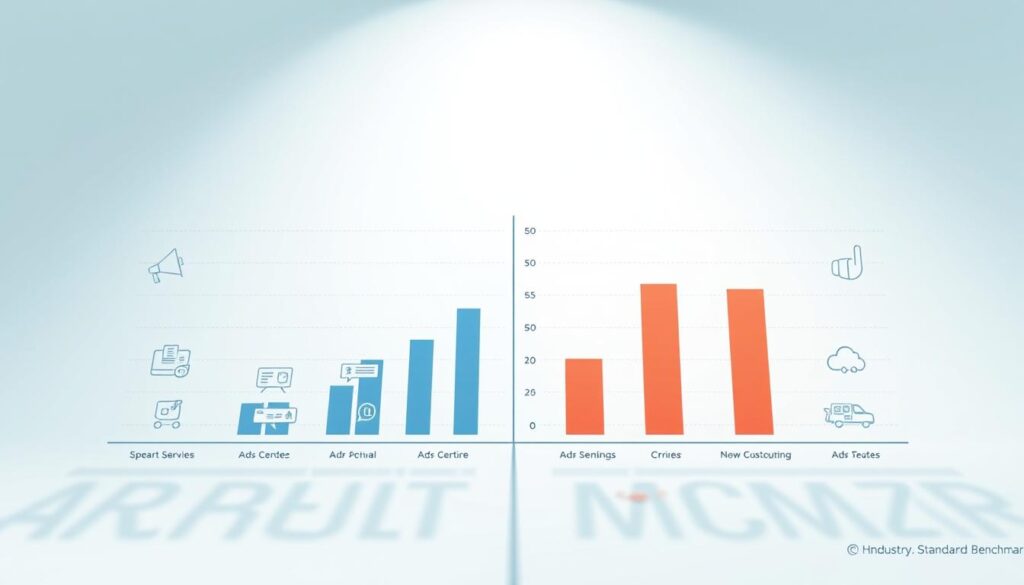Did you know that 30% of small businesses waste up to 40% of their ad budget? This is because of poor planning. With digital channels growing, knowing what is a good ad budget? is key for entrepreneurs. They want to get the most value without spending too much.
Startups and big companies alike face the challenge of matching their advertising budget to their growth goals. A good budget is more than just a number. It’s a plan that helps turn ad spending into new customers and loyal fans.
Key Takeaways
- Effective ad budgets focus on meeting business goals, not just random numbers.
- More than 60% of businesses now use data to adjust their ad budgets.
- Without planning, money is wasted. But smart budgeting can boost ROI by up to 300%.
- Knowing industry standards and growth stages helps set a good ad budget.
- Optimizing ad spend means keeping an eye on it and being ready to adjust to changes.
Understanding the Importance of Strategic Ad Spending
Effective ad spending is key for business growth today. A good ad budget strategy means using resources wisely. It helps get the best return on investment. Small businesses often miss how ads help get new customers and make their brand known.
But, studies show that companies with a clear budget plan do better. They can grow their market share by up to 40%.
The Impact of Advertising on Business Growth
Advertising has three main benefits:
- Brand awareness: Regular ads make customers more familiar with a brand by 28% (2023 DMA Report).
- Lead generation: Ads that target the right people can get 15% more leads than random ads.
- Revenue expansion: Spending 10% more on ads each year can lead to a 7.5% increase in revenue.
Why Budget Planning Matters in Digital Marketing
Planning your budget helps avoid wasting money and keeps your goals in sight. Important parts include:
- Tracking ROI with tools like Google Analytics
- Changing your budget based on how well ads do
- Setting aside 15-30% of your marketing budget for ads
Balancing Ad Spend with Overall Marketing Budget
| Business Stage | Recommended Ad Spend % | Focus Areas |
|---|---|---|
| Startup | 15-20% | Brand awareness, customer education |
| Established | 20-25% | Customer retention, competitive positioning |
| Scaling | 25-35% | Market expansion, lead generation |
“Proactive budget planning reduces wasted spend by up to 30% while improving campaign effectiveness.” — 2024 AdAge Industry Report
What is a Good Ad Budget? Breaking Down the Fundamentals
Figuring out a good ad budget means linking spending to your business goals. Many wonder, “what is a good ad budget?” But, it really depends on your specific situation. Good advertising budgets are flexible and based on data, not just numbers.
- Percentage of revenue: Commonly 2-5% of annual revenue for small businesses
- Competitive parity: Matching competitors’ spending in market segments
- Objective-based: Allocating funds to specific goals like brand awareness or sales
- Zero-based: Starting at zero and building costs from project requirements
| Method | Description | Best For |
|---|---|---|
| Percentage of Sales | Uses past revenue to calculate spending | Stable revenue streams |
| Competitive Analysis | Matches industry spending levels | Market share-focused businesses |
| Objective-Driven | Targets specific campaign goals | Goal-oriented startups |
“A good advertising budget isn’t about the number—it’s about the outcomes it enables.”
For example, a bakery might spend $500 a month for a seasonal campaign. A tech startup might use 3% of revenue for new product launches. It’s important to check how your budget is doing regularly. Don’t stick to one way of doing things; keep adjusting based on what works.
Key Factors That Should Influence Your Advertising Budget
Setting an ad budget effectively involves looking at four main factors. These factors help match your budget with your business goals, the market, and your financial situation. Knowing these helps avoid spending too much or too little.
Business Size and Revenue Considerations
The size of your business affects how much you should spend on ads. Here’s a table showing how much to spend based on your revenue:
| Business Size | Revenue Range | Recommended Ad Spend % |
|---|---|---|
| Micro (1-10 employees) | $100k–$1M | 3–5% |
| Small ($1M–$10M) | 5–8% | |
| Medium ($10M–$100M) | 8–12% | |
| Enterprise ($100M+) | 10–15% |
Industry-Specific Advertising Standards
- Retail and CPG sectors usually spend 10–15% of their revenue on ads.
- Professional services like legal and consulting spend 5–8%.
- Healthcare and tech firms balance their R&D and marketing budgets carefully.
Growth Stage and Business Objectives
- Startups focus on building brand awareness, spending 10–15% of their budget.
- Mature businesses aim to keep customers, spending 5–8%.
- Companies in transition might increase spending to 15–20% temporarily.
Competitive Landscape Analysis
Effective ad budgeting also means:
- Looking at how often competitors advertise and where.
- Checking if the market is too crowded to avoid wasting money.
- Deciding whether to spend the same, more, or less than competitors.
“Competitive parity isn’t always the goal—strategic differentiation often drives better ROI.” – Digital Marketing Institute
By considering these factors, businesses can avoid common mistakes. They can make sure their budgets support their long-term goals. Using data to guide spending helps grow without wasting resources.
Proven Methods to Calculate Your Optimal Ad Budget
Small businesses have four proven ways to figure out their effective ad budget. Each method meets different business needs and market situations. Here are the steps to follow:
“A well-structured advertising budget turns guesswork into strategy.” – Digital Marketing Institute
Percentage of Revenue Method
- Use past or projected revenue to calculate
- For established businesses, 5-12% is good; 12-20% for growth
- Example: $500k revenue means $25k-$60k budget
Objective and Task Method
- Set budget based on specific goals (like 20% lead growth)
- Split costs into parts (creative, platform fees)
- Example: $5k/month for 3 months to generate leads
Competitive Parity Approach
- Keep an eye on industry standards and what competitors spend
- Adjust your budget to match the market but stay unique
- Example: Spend 80% like competitors and 20% on new ideas
Incremental Testing Strategy
- Start with small budgets ($500-$2,000)
- Check ROI weekly with CPA and CTR
- Grow budgets by 10-15% when returns are steady
| Method | Best For | Key Advantage |
|---|---|---|
| Percentage of Revenue | Stable businesses | Consistent growth alignment |
| Objective-Based | Goal-driven campaigns | Targeted resource allocation |
| Competitive Parity | Market-maturing phases | Maintain market position |
| Incremental Testing | New markets | Risk mitigation |
Use tools like Google Analytics and Meta Business Suite for detailed tracking. Regular checks keep your advertising budget in line with your business’s changing needs.
Effective Ad Budget Allocation Across Marketing Channels
Effective ad budget allocation means matching spending with your business goals and what your audience likes. First, check how your current channels are doing. For instance, B2B companies usually put more money into LinkedIn and email. On the other hand, B2C brands might spend more on Instagram and Facebook ads.
- B2B businesses: Spend 30-40% of online advertising budget on LinkedIn and SEO.
- B2C brands: Focus on social media (40-50%) and Google Ads (30%) for getting new customers.
- Service-based companies: Use local SEO and Google My Business to get more direct inquiries.
- Startups: Start with small amounts on TikTok and YouTube ads before increasing your budget.
Even though traditional media like TV or print might be useful for local businesses, digital channels are key for seeing how well your ads work. Set aside 5-10% of your budget for new platforms to test them out. Use tools to track how well your ads are doing, and use that info to adjust your spending.
Data shows 68% of small businesses increase online advertising budget when campaigns hit 5%+ ROI thresholds.
It’s important to make sure your different marketing channels work well together. For example, using Google Ads with Facebook retargeting can help more people see your ads. Don’t spread your budget too thin—put at least $500 a month into each platform to get useful data. Check how your ads are doing every quarter and change your spending based on what you learn.
Industry Benchmarks: How Your Ad Spending Compares
Looking at your ad budget against industry standards helps you see if you’re on track. These standards help shape your strategy without forcing a one-size-fits-all approach.

Small Business Advertising Benchmarks
Small businesses with less than $5 million in revenue usually spend 5–10% of their annual income on ads. Key points include:
- Top sectors like retail and services spend 8–12% on digital ads
- Average customer acquisition cost (CAC) ranges from $50–$200
- Social media and search ads dominate channel allocations (60–70%)
Mid-Size Company Ad Budget Standards
Companies earning $5–50 million often aim to spend 3–6% of their revenue on ads. Trends show:
- Increased focus on email marketing and retargeting campaigns
- ROI expectations rise to 3–5x initial investment
- TV and radio ads re-enter budgets for brand awareness
Enterprise-Level Ad Spending Patterns
Large firms over $50 million often spend 1–3% of their revenue on ads. Their strategies focus on:
- Data-driven attribution modeling
- 60% of budgets allocated to brand-building campaigns
- Real-time bidding (RTB) for programmatic ad efficiency
| Business Type | Ad Spend % of Revenue | Key Channels | ROI Target |
|---|---|---|---|
| Small | 5–10% | Social, search, email | 2–4x |
| Mid-Size | 3–6% | TV, retargeting, podcasts | 3–5x |
| Enterprise | 1–3% | Programmatic, video, OOH | 4–6x |
Data from the 2023 IAB report shows 68% of businesses now track ad spend against customer lifetime value (CLV), not just initial sales.
While benchmarks guide decision-making, adapt them to your unique goals. A bakery in a competitive market might exceed small-business averages, while a SaaS startup might prioritize performance ads over brand campaigns. Regular audits against these benchmarks ensure your advertising budget stays aligned with growth objectives.
Maximizing ROI: Strategies to Optimize Your Advertising Investment
To turn ad spending into profit, you need strategies that match spending with results. Here are ways to use advertising cost optimization to protect and grow your effective ad budget.
Performance Tracking and Analytics
Start by tracking important metrics like click-through rates (CTR), conversion rates, and customer acquisition cost (CAC). Use tools like Google Analytics or Meta Business Suite to gather data. For e-commerce, track cart abandonment rates and ad spend per customer.
Advertising cost optimization begins with knowing how to attribute sales. Choose last-click, first-click, or time-decay models based on your sales cycle.
A/B Testing to Improve Ad Efficiency
Test variables systematically using these protocols:
| Test Type | Variables | Key Metrics |
|---|---|---|
| Creative Elements | Headlines, visuals, call-to-action | CTR improvement, conversion lift |
| Audience Targeting | Demographics, interests, location | Cost per lead, audience retention |
| Bid Strategies | Manual vs. automated bidding | ROAS (return on ad spend), budget utilization |
Budget Reallocation Based on Performance Metrics
Review your budget every quarter to see where it’s most valuable. Use marginal ROAS analysis to decide. If one campaign has a 4:1 ROAS and another has a 2:1, move 20% of the lower ROAS budget to the higher one.
Don’t make sudden changes. Make adjustments over 4-6 weeks. Here’s a framework:
- Weekly: Watch daily spend vs. conversion trends
- Monthly: Update cost-per-acquisition benchmarks
- Quarterly: Move 10-15% of total budget based on performance
Keep refining to avoid over-optimizing. Keep 10-20% of your effective ad budget for testing new channels. This mix of proven strategies and innovation works well.
Common Ad Budget Mistakes and How to Avoid Them
Creating a good ad budget strategy means avoiding common mistakes. Small businesses often make errors that hurt their return on investment. Here are some key mistakes to watch out for:

- Underfunding Below Thresholds: Campaigns need a minimum spend to show results. Watch for campaigns with low impressions or reach.
- Inconsistent Spending: Changing budgets can mess up trend analysis. Check if your spending is steady over 3+ months.
- Last-Click Attribution Bias: Focusing too much on the last click can be misleading. Use multi-touch attribution models in tools like Google Analytics.
- Ignoring Brand-Building: Only focusing on short-term gains can overlook long-term value. Spend 15-20% of your budget on brand awareness.
| Mistake | Detection Method | Corrective Action |
|---|---|---|
| Seasonality Blindness | Compare QoQ spending patterns | Adjust quarterly budgets using historical sales data |
| Testing Underfunding | Track new channel spend below $500/month | Allocate 10% of total budget to testing phases |
| Economic Downturn Cuts | Identify abrupt budget drops during recessions | Maintain core budgets while scaling back non-essential channels |
Starting to follow ad budget best practices means doing regular checks. Use tools like Facebook Ads Manager’s Budget Insights to spot issues. Hold quarterly budget reviews to keep everyone on the same page. Avoiding these mistakes is key to lasting growth, not just tweaking what you already do.
Conclusion: Creating a Sustainable Ad Budget Strategy for Long-Term Success
Creating a lasting ad budget strategy begins with understanding key principles. It’s about matching investments with your business goals and industry standards. Using methods like the percentage of revenue model helps avoid mistakes and smart resource allocation.
Keeping an eye on performance and analyzing data is essential. Watch metrics like ROI and click-through rates to adjust budgets as needed. Being flexible yet consistent helps meet long-term goals without losing sight of them.
Technology and consumer habits change fast, requiring quick adjustments. Using tools like A/B testing or automation can improve campaigns. A sustainable strategy focuses on long-term growth, seeing ads as investments, not expenses.
Setting an ad budget is an ongoing process. Begin with clear goals, test ideas, and adjust based on results. Working with platforms like Google Ads or Meta Business Suite helps track progress. Learning from each campaign keeps budgets in line with market and business needs.
Future trends, like AI targeting and new ad formats, will influence budget planning. Regular reviews and audits help stay agile. Making informed choices over guesses builds strong, growing strategies.

